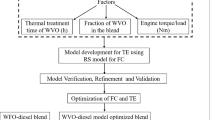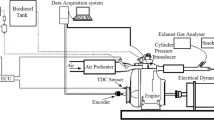Abstract
To make full use of the dissipated energy of internal combustion engines (ICEs), it is necessary to recover all the waste heat contained in the intake air, exhaust gases, and the coolant streams. This investigation proposed a dual-loop ORC (DORC) system for waste heat recovery (WHR) of a 12-cylinder stationary heavy-duty Diesel (HDD) engine. The numerical model of the 1000 kW diesel engine is developed 1-dimensionally and validated by experimental data. Regression equation models of output responses are formulated via response surface methodology (RSM). The multi-objective optimization is applied to optimize the responses of the system based on the desirability function approach. A comprehensive sensitivity analysis (SA) by means of RSM is accomplished to discover sensitivity of the start of injection (SOI), engine speed (N), higher pressure of the high-temperature loop (HPHT), and higher pressure of the low-temperature loop (HPLT) on output responses. The SA reveals that total produced power increases by increasing the SOI, N, and HPHT. The engine variables are not affecting the thermal efficiency and exergy destruction rate. Moreover, increasing the HPHT and HPLT boosts the exergy efficiency of the system. The dominant parameter affecting all outputs is the HPLT. Furthermore, the optimized output responses of the system are as follows: the net produced power of 304 kW, the thermal efficiency of 9.75%, the exergy efficiency of 45.84%, and the exergy destruction rate of 361 kW.















Similar content being viewed by others
Abbreviations
- d :
-
Individual desirability
- D :
-
Combined desirability function
- e :
-
Specific exergy (kJ/kg)
- \(\dot{E}\) :
-
Exergy rate (kW)
- L :
-
Lowest value
- m :
-
Mass (kg)
- \(\dot{m}\) :
-
Mass flow rate (kg/s)
- N :
-
Engine Speed (RPM)
- P :
-
Pressure (kPa)
- T :
-
Target value
- \(\dot{W}\) :
-
Power (kW)
- w :
-
Weight for individual desirability
- Y :
-
Predicted value
- \(\eta\) :
-
Efficiency
- bTDC:
-
Before top dead center
- CA:
-
Crank angle
- HT:
-
High temperature
- HPHT:
-
Higher pressure of the HT loop
- HPLT:
-
Higher pressure of the LT loop
- ICE:
-
Internal combustion engine
- LT:
-
Low temperature
- MFR:
-
Mass flow rate
- MOO:
-
Multi-objective optimization
- ORC:
-
Organic Rankine cycle
- SA:
-
Sensitivity analysis
- SOI:
-
Start of injection
- WHR:
-
Waste heat recovery
- D:
-
Destruction
- e :
-
Outlet
- ex:
-
Exergy
- i :
-
Inlet
- PP:
-
Pinch point
- S:
-
Source
- th:
-
Thermal
References
Braimakis K et al (2020) Exergetic performance of CO2 and ultra-low GWP refrigerant mixtures as working fluids in ORC for waste heat recovery. Energy 203:117801
Pan M et al (2020) Theoretical analysis and comparison on supercritical CO2 based combined cycles for waste heat recovery of engine. Energy Convers Manage 219:113049
Shi L et al (2018) A review of modified Organic Rankine cycles (ORCs) for internal combustion engine waste heat recovery (ICE-WHR). Renew Sustain Energy Rev 92:95–110
Luo D, Sun Z, Wang R (2022) Performance investigation of a thermoelectric generator system applied in automobile exhaust waste heat recovery. Energy 238:121816
Pasini G et al (2016) Evaluation of an electric turbo compound system for SI engines: a numerical approach. Appl Energy 162:527–540
Teo AE et al (2019) Performance evaluation of low-pressure turbine, turbo-compounding and air-Brayton cycle as engine waste heat recovery method. Energy 166:895–907
Emadi MA et al (2020) Working-fluid selection and thermoeconomic optimisation of a combined cycle cogeneration dual-loop organic Rankine cycle (ORC) system for solid oxide fuel cell (SOFC) waste-heat recovery. Appl Energy 261:114384
Georgousopoulos S et al (2021) Thermodynamic and techno-economic assessment of pure and zeotropic fluid ORCs for waste heat recovery in a biomass IGCC plant. Appl Therm Eng 183:116202
Miao Z et al (2020) Selection criteria of zeotropic mixtures for subcritical organic Rankine cycle based on thermodynamic and thermo-economic analysis. Appl Therm Eng 180:115837
Eyerer S et al (2020) Advanced ORC architecture for geothermal combined heat and power generation. Energy 205:117967
Shu G et al (2014) Study of mixtures based on hydrocarbons used in ORC (Organic Rankine Cycle) for engine waste heat recovery. Energy 74:428–438
Song J, Gu C-W (2015) Performance analysis of a dual-loop organic Rankine cycle (ORC) system with wet steam expansion for engine waste heat recovery. Appl Energy 156:280–289
Bekiloğlu HE, Bedir H, Anlaş G (2019) Multi-objective optimization of ORC parameters and selection of working fluid using preliminary radial inflow turbine design. Energy Convers Manage 183:833–847
Huang W et al (2019) Performance analysis and optimization of a combined cooling and power system using low boiling point working fluid driven by engine waste heat. Energy Convers Manage 180:962–976
da Silva JAM et al (2018) Exergy evaluation and ORC use as an alternative for efficiency improvement in a CI-engine power plant. Sustain Energy Technol Assess 30:216–223
Di Cairano L, Bou Nader W, Nemer M (2021) A simulation and experimental study of an innovative MAC/ORC/ERC system: ReverCycle with an ejector for series hybrid vehicles. Energy 230:120830
Pallis P et al (2021) Development, experimental testing and techno-economic assessment of a fully automated marine organic Rankine cycle prototype for jacket cooling water heat recovery. Energy 228:120596
Wang S et al (2021) Techno-economic-environmental evaluation of a combined cooling heating and power system for gas turbine waste heat recovery. Energy 231:120956
Braimakis K, Grispos V, Karellas S (2021) Exergetic efficiency potential of double-stage ORCs with zeotropic mixtures of natural hydrocarbons and CO2. Energy 218:119577
Fang Y, Yang F, Zhang H (2019) Comparative analysis and multi-objective optimization of organic Rankine cycle (ORC) using pure working fluids and their zeotropic mixtures for diesel engine waste heat recovery. Appl Therm Eng 157:113704
Behzadi A et al (2018) Multi-objective optimization and exergoeconomic analysis of waste heat recovery from Tehran’s waste-to-energy plant integrated with an ORC unit. Energy 160:1055–1068
Özahi E, Tozlu A, Abuşoğlu A (2018) Thermoeconomic multi-objective optimization of an organic Rankine cycle (ORC) adapted to an existing solid waste power plant. Energy Convers Manage 168:308–319
Yang F et al (2018) Artificial neural network (ANN) based prediction and optimization of an organic Rankine cycle (ORC) for diesel engine waste heat recovery. Energy Convers Manage 164:15–26
** X et al (2021) Prediction and optimization of power output of single screw expander in organic Rankine cycle (ORC) for diesel engine waste heat recovery. Appl Therm Eng 182:116048
Gamma Technologies (2016) GT-SUITE Manual
Boodaghi H, Etghani MM, Sedighi K (2021) Performance analysis of a dual-loop bottoming organic Rankine cycle (ORC) for waste heat recovery of a heavy-duty diesel engine, part I: thermodynamic analysis. Energy Convers Manag 241:113830
Wu Z et al (2020) Performance evaluation and working fluid selection of combined heat pump and power generation system (HP-PGs) using multi-objective optimization. Energy Convers Manage 221:113164
Huster WR, Schweidtmann AM, Mitsos A (2020) Working fluid selection for organic Rankine cycles via deterministic global optimization of design and operation. Optim Eng 21(2):517–536
Zhang X et al (2019) Selection and evaluation of dry and isentropic organic working fluids used in organic Rankine cycle based on the turning point on their saturated vapor curves. J Therm Sci 28(4):643–658
Moler C et al (1987) Pro-Matlab, user’s guide. The Mathworks
Lemmon E, Huber M, McLinden MJSRDP, Gaithersburg (2007) NIST Standard Reference Database 23: Reference Fluid Thermodynamic and Transport Properties-REFPROP, Version 8.0. National Institute of Standards and Technology, Standard Reference Data Program
Mao N et al (2018) Comparative studies on using RSM and TOPSIS methods to optimize residential air conditioning systems. Energy 144:98–109
Prasad GA et al (2021) Response surface methodology to predict the performance and emission characteristics of gas-diesel Engine working on producer gases of non-uniform calorific values. Energy 234:121225
Solmaz H et al (2021) Prediction of performance and exhaust emissions of a CI engine fueled with multi-wall carbon nanotube doped biodiesel-diesel blends using response surface method. Energy 227:120518
Solmaz H et al (2020) Optimization of the operating conditions of a beta-type rhombic drive stirling engine by using response surface method. Energy 198:117377
Lei X-S et al (2019) Parametric study and optimization of dimpled tubes based on response surface methodology and desirability approach. Int J Heat Mass Transf 142:118453
Mirbagheri SA, Safieddin Ardebili SM, Kiani Deh Kiani M (2020) Modeling of the engine performance and exhaust emissions characteristics of a single-cylinder diesel using nano-biochar added into ethanol-biodiesel-diesel blends. Fuel 278:118238
Pandey A et al (2020) Multi-objective optimization of media components for improved algae biomass, fatty acid and starch biosynthesis from Scenedesmus sp. ASK22 using desirability function approach. Renew Energy 150:476–486
Mohapatra T, Sahoo SS, Padhi BN (2019) Analysis, prediction and multi-response optimization of heat transfer characteristics of a three fluid heat exchanger using response surface methodology and desirability function approach. Appl Therm Eng 151:536–555
Srinidhi C et al (2021) RSM based parameter optimization of CI engine fuelled with nickel oxide dosed Azadirachta indica methyl ester. Energy 234:121282
Milani Shirvan K et al (2017) Numerical investigation and sensitivity analysis of effective parameters to obtain potential maximum power output: a case study on Zanjan prototype solar chimney power plant. Energy Convers Manage 136:350–360
Zheng N et al (2017) Numerical simulation and sensitivity analysis of heat transfer enhancement in a flat heat exchanger tube with discrete inclined ribs. Int J Heat Mass Transf 112:509–520
Nakhchi ME, Esfahani JA (2019) Sensitivity analysis of a heat exchanger tube fitted with cross-cut twisted tape with alternate axis. J Heat Transf 141(4):041902
Campolongo F, Braddock R (1999) The use of graph theory in the sensitivity analysis of the model output: a second order screening method. Reliab Eng Syst Saf 64(1):1–12
Saltelli A, Tarantola S, Chan KPS (1999) A quantitative model-independent method for global sensitivity analysis of model output. Technometrics 41(1):39–56
Author information
Authors and Affiliations
Corresponding author
Additional information
Technical Editor: Luben Cabezas-Gómez.
Publisher's Note
Springer Nature remains neutral with regard to jurisdictional claims in published maps and institutional affiliations.
Appendix A
Rights and permissions
Springer Nature or its licensor holds exclusive rights to this article under a publishing agreement with the author(s) or other rightsholder(s); author self-archiving of the accepted manuscript version of this article is solely governed by the terms of such publishing agreement and applicable law.
About this article
Cite this article
Boodaghi, H., Etghani, M.M. & Sedighi, K. A novel investigation of waste heat recovery from a stationary diesel engine using a dual-loop organic Rankine cycle. J Braz. Soc. Mech. Sci. Eng. 44, 369 (2022). https://doi.org/10.1007/s40430-022-03680-y
Received:
Accepted:
Published:
DOI: https://doi.org/10.1007/s40430-022-03680-y




